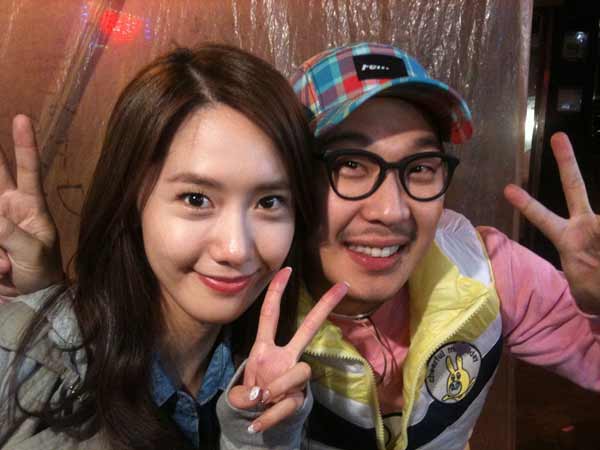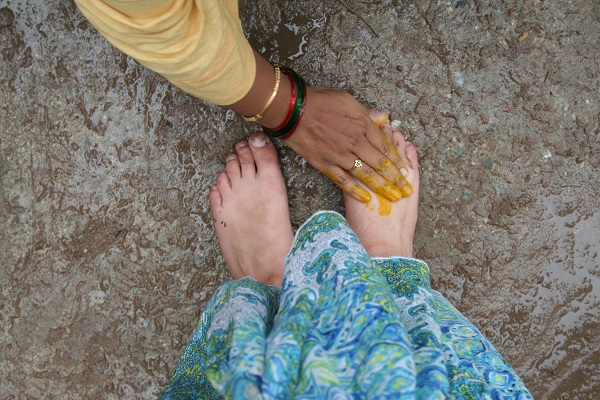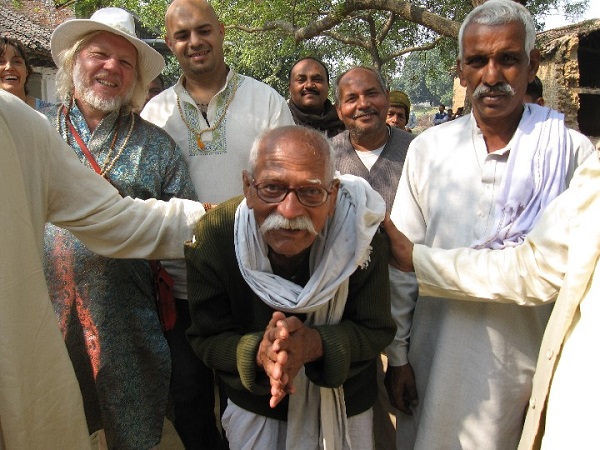We flash the V sign while posing for pictures, not knowing that the ‘V’ has a variety of serious connotations.
 by Shweyta Mudgal
by Shweyta Mudgal
One of the many social idiosyncrasies that I’ve witnessed, during my days spent living in Asia, is seeing Asians pose for photographs. More often than not, when one walks past a group of young Asians (and sometimes older ones too) posing for a picture or if one has been requested to put down one’s babo or even one’s baby to don the photographer’s hat for such a group, one will find oneself faced with a group of smiling faces with random ‘V’ signs that suddenly crop up in the background, before you can say cheese!
It is a gesture instinctively thrown up every time Asians see a camera, the ‘V’ sign, made with one’s index and middle finger – a visual representation as if to say out loud – “I feel happy, things are good, life is awesome.”
The origins of this ‘cultural quirk’, can be traced back to various events in the past. And like many other such global impartations of our times, this act of ‘V’ sign-making symbolism during photography, is also a Western influence on Eastern culture.
In the West, the ‘V’ sign with the palm facing outwards had two major associations –
1. Winston Churchill
 Churchill wanted the sign to stand for ‘Victory’ during World War II. He initially made the ‘V’ with his palm-inwards (see pic on left), a gesture that he didn’t know the negative meaning of, being a wealthy member of the upper class.
Churchill wanted the sign to stand for ‘Victory’ during World War II. He initially made the ‘V’ with his palm-inwards (see pic on left), a gesture that he didn’t know the negative meaning of, being a wealthy member of the upper class.
A ‘V’ sign flashed with the palm facing inwards, has negative connotations in the West. It supposedly originates from the time when British bowmen were an extremely potent military force. Their great enemies, the French, on capturing them, would sever their first two fingers, so that they could no longer pull the bowstring, thus literally disarming them. When the English defeated the French, they insulted the retreating soldiers with the ‘V’ sign, palm inward, to show both fingers intact. In modern-day lingo, this hand symbol has literally come to mean “Up yours”.
However when corrected by his aides, Churchill reversed his hand (palm facing outwards), thus giving the iconic two-fingered ‘V for Victory’ pose that is now known all around the world.
2. The 1960s anti-war movement
Some trace the emergence of the ‘V’ sign as we know it today, back to the 1960s, when the American anti-war movement used it to signify Vietnam, calling for peace whilst making the gesture. Gradually the gesture itself came to mean ‘peace’ and was popularised by the flower power movement and peacenik luminaries such as Yoko Ono and John Lennon. The sign became iconic for the age of Woodstock and free love. This was the beginning of the association of the V sign with happiness and positivity.
In Asia, multiple theories suggest that this finger-phenomenon first began in Japan. Some believe it directly resulted out of the nation’s adulation for their favourite American band, The Beatles.
Some other theories attribute the origination of this hand symbol in Japan to after World War II, when the defeated Japanese were flashed the ‘Peace’ and ‘Victory’ signs by the victorious American soldiers. This trend was emulated and continues to be so, up to the present day, when many Japanese youngsters still flash the ‘V’ sign in pictures, purely out of cultural conditioning, without knowing what it really stood for.
 Yet another theory connects this hand-sign practice to the American figure skater and anti-war activist Janet Lynn, who won over the hearts, minds and fingers of the photographed masses, in the 1972 Sapporo Olympics. She became beloved in Japan both for her artistic performance and for staying upbeat even after she fell on the ice. The theory goes that her frequent showing of the peace sign in subsequent print and TV media coverage in Japan won imitators.
Yet another theory connects this hand-sign practice to the American figure skater and anti-war activist Janet Lynn, who won over the hearts, minds and fingers of the photographed masses, in the 1972 Sapporo Olympics. She became beloved in Japan both for her artistic performance and for staying upbeat even after she fell on the ice. The theory goes that her frequent showing of the peace sign in subsequent print and TV media coverage in Japan won imitators.
A pragmatic evolution story, that seems most believeable on pure grounds of its simplicity and realism is this: In Japan, when photographers take pictures of children, they ask “Ichi to ichi wa?” (What is one plus one?) to get them to smile. The answer comes, “Neeeeeee!” (Two!) with a big smile. This is the Japanese equivalent of “Say cheese”. Naturally, some people also respond figuratively – by putting up two fingers to visually indicate two at the same time.
Since the two fingers are the same as the peace sign gesture, it is theorised that one custom probably morphed into the other. Japan, being the trendsetter that it has always been among other Asian countries, thus pioneered this subconscious and popular picture-posing phenomenon, sending across an official ‘V-sign memo’ kind of pose, around the entire Asian continent.
Asian subcultures, over the years, have come up with various adaptations of the ‘V’ sign, adding their own definitions and finishing touches to it, while posing for photographs. While the Thai version is one of the thumb and index finger around the face, indicating that the subject is handsome/beautiful, the Koreans hold the ‘V’ close to their face, hoping they can  trick you into believing they have what is believed to be the perfect face shape – V (see pic on right). The otherwise conventionally happy sign has also seen a gangster-isation off late, complete with the palm inwards, fingers held sideways like scissors – a sign that has moved on from saying “I am happy” to “Don’t mess with me. I am just too cool.”
trick you into believing they have what is believed to be the perfect face shape – V (see pic on right). The otherwise conventionally happy sign has also seen a gangster-isation off late, complete with the palm inwards, fingers held sideways like scissors – a sign that has moved on from saying “I am happy” to “Don’t mess with me. I am just too cool.”
Being a happy poser all my life, I’ve always loved smiling for the camera. In the days of pre-digital picture-taking, when one could not see a photograph immediately after it was taken, it was not possible to know right away if one’s picture would end up flattering or shattering one’s image. All one could do then, was to hope, that once developed and printed, the picture would be perfect – where one’s eyes had stayed open, one’s smile had been perfect and one looked as photogenic as possible.
Yet more often than not, when the stars would align on all of the above, the photograph would show a mysterious set of alien fingers protruding above one’s head, foiling the entire image in the process, much to the chagrin of oneself and the amusement of one’s co-posers. In India, this is how the ‘V’ sign took on a negative image-tarnishing role, in the form of prankish symbolism – when ‘devil’s horns’ or ‘bunny’s ears’ pop up unknowingly behind one’s head, ruining their picture in the process.
The simple “Say Cheese” phrase that originated in the West, has come a long way and picked up varied symbolism en route its journey to the East. Whichever person or combination of events sparked it, the gesture of holding up a ‘V’ with the fingers while posing for a picture, now far removed from its original meanings, has entered the collective unconscious and stayed there. While to some it takes on the role of being a tool of vanity – to chisel one’s facial geometry into their notions of perfection for a photograph, to others it simply helps radiate happy, cutesy, cool or seemingly innocent vibes to be captured in a moment. To others, it offers up a proud platform for the announcement of victory, as it originally did for Churchill, or in the case of the Arab world, where Iraqi voters joyously flashed their ‘V’ fingers stained with the dye used to mark those who voted. To some it is an anti-war pledge while being a plea for peace and a symbol of freedom as seen not too long ago in pictures of ‘V’ flashing protestors from Libya, Egypt, Yemen, Jordan and Bahrain, where it served as a sign of popular resistance to be used while bringing down torturous governments.
From a simple, purely nonsensical sign to a serious, powerful symbol of fighting oppression, the ‘V’ sign in photography has come a long way! While it has paramount importance in some cases, in some others it is hardly tangible, getting flashed subconsciously anyway, at the slightest prospect of a picture being taken. To me though, it is most successful when it is taken out of the picture and placed atop the head of an unsuspecting photographer, in the form of ‘bunny’s ears’. Try it the next time you walk by a group getting their picture taken by someone. To bring out the loud guffaws and ear-to-ear grins of an unknown group of people, just in time for when the shutterbug clicks the shot, to frame it in their memory forever – that is the power of the ‘V’, according to me!
A Mumbaikar by birth and a New Yorker by choice, recently-turned global nomad Shweyta Mudgal is currently based out of Singapore. An airport designer by day, she moonlights as a writer. ‘Outside In’ is a weekly series of expat diaries, reflecting her perspective of life and travel, from the outside-in. She blogs at www.shweyta.blogspot.com and would much rather have people keep their hands to themselves, when being photographed – so that for once, she can be the one giving someone ‘devil’s horns’ instead.
(Pictures courtesy message.snopes.com, almabsar.over-blog.com, www.dkpopnews.net, sunnbo.tumblr.com)





